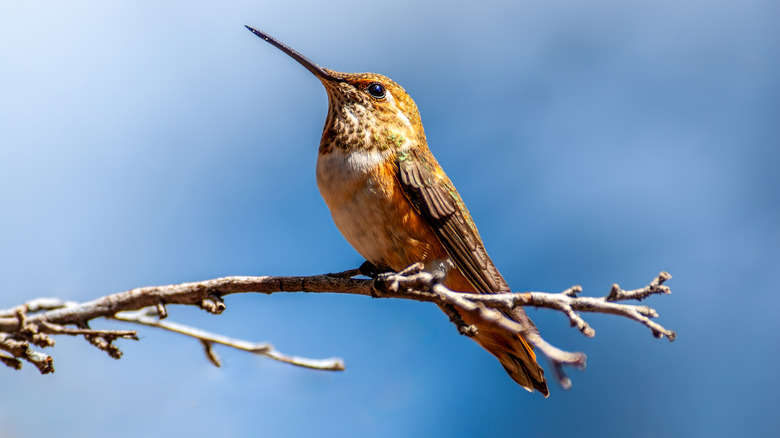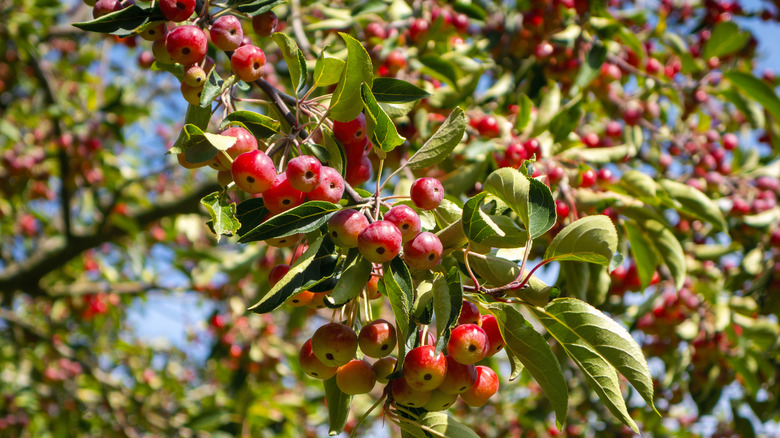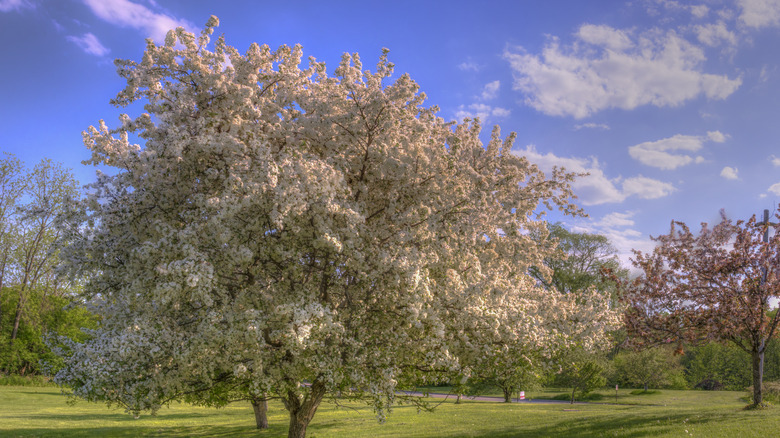The Colorful Tree To Plant In Your Yard If You Want To Attract Hummingbirds
Hummingbirds add an ethereal charm to any garden they grace. These small, agile birds with an iridescent plumage and rapid wingbeats create a humming sound as they dart from flower to flower. Needless to say, they're amusing to watch as they perform their cute little dances. But beyond the joy they provide, hummingbirds offer numerous benefits to gardens. Aside from being natural pollinators, hummingbirds feed on pests like aphids, mosquitoes, and gnats, helping to keep the populations of these bugs in check without the need for harmful pesticides. This is why gardeners often seek to attract hummingbirds, employing various methods to entice them into their garden, including planting nectar-rich flowers, hanging feeders filled with sugar water, and creating a suitable habitat for them with certain kinds of shrubs. While these approaches can be effective, there's another method that will encourage these graceful little birds to come and simultaneously add beauty to your garden: planting a crabapple tree.
The crabapple tree is a wonderful addition to any garden as it will not only enhance the aesthetics of your patch of green but can also serve as a magnet for hummingbirds. Crabapples typically produce beautiful white, pink, purplish, or deep-red flowers, and bear small, sour fruits reminiscent of true apples. They originated in Asia and North America and have been cultivated for centuries for their ornamental and culinary value.
Crabapples: a hummingbird haven
What makes crabapple trees particularly alluring to hummingbirds is their abundant blossoms, which are rich in nectar and irresistible to these tiny avian visitors. Beyond their appeal to hummingbirds, crabapples offer a host of benefits to gardeners, including their beautiful spring blooms, colorful foliage, and potential for fruit production for culinary use or wildlife consumption.
Crabapple trees also help with apple tree pollination, so having one in your garden means good news for your community if apple trees grow within your vicinity. While crabapple and apple trees belong to the same genus (Malus domestica), the latter are known to produce sterile pollen. It's a good thing they often bloom at the same time as crabapple trees which produce abundant flowers rich in fertile pollen. Since they are closely related, crabapples and apples are compatible for cross-pollination. Hummingbirds, bees, butterflies, and other pollinating insects are attracted to the flowers of both crabapples and apple trees, facilitating the transfer of pollen between them. So, with both trees in your neighborhood or garden, you'll not only get to enjoy fresh, tart crabapples but also crunchy, sweet apples. Also, crabapples are early bloomers and keep flowering for longer. This means that the presence of pollinators attracted to crabapple blossoms can also benefit other nearby fruit trees, including cherries, plums, and pears, further enhancing fruit production in the garden or orchard ecosystem.
Planting and caring for crabapple trees
Growing a crabapple tree requires careful consideration of soil conditions, sunlight exposure, and spacing to ensure optimal growth and health. Plant your crabapple during spring or fall. Choose a site with well-drained soil and full sun for best results. When planting, use the root ball as your reference. Dig a hole twice its width, with a depth that's 6 inches deeper than the root ball. If you're planting several crabapples, they should ideally be spaced 10 to 20 feet apart so there's ample room for growth.
Once planted, regular watering (1 inch of water every week after planting and 2 inches during hot, dry periods), mulching, and fertilization with a slow-release, balanced fertilizer will promote healthy growth and abundant blooms. Prune the tree in late winter or early spring to remove dead or diseased branches, and shape the tree for optimal aesthetics. Inspect your crabapple to ensure it's free from disease and protect it from pests like spider mites, borers, and aphids. Remember that young crabapple trees take a few years to mature before they bloom and bear fruit. So, be patient with your tree as it establishes itself. With proper care, your crabapple tree will flourish, attracting not only hummingbirds but also the admiration of onlookers as it thrives and blooms in your garden.


